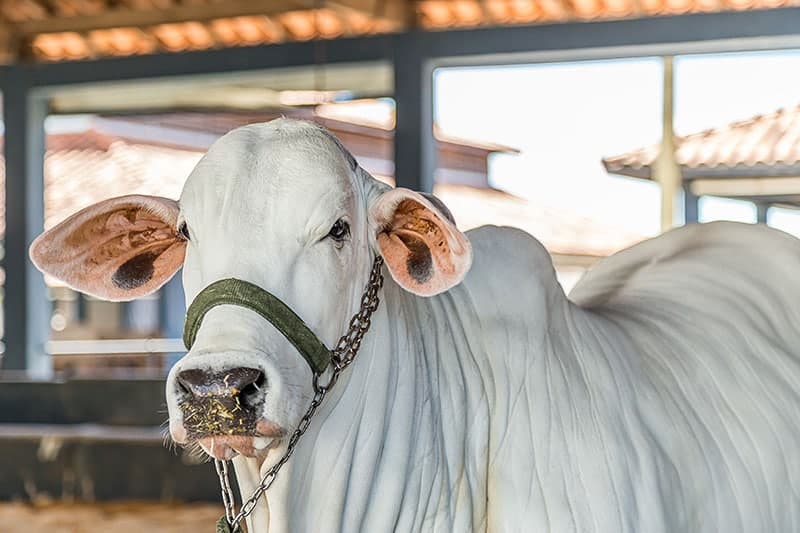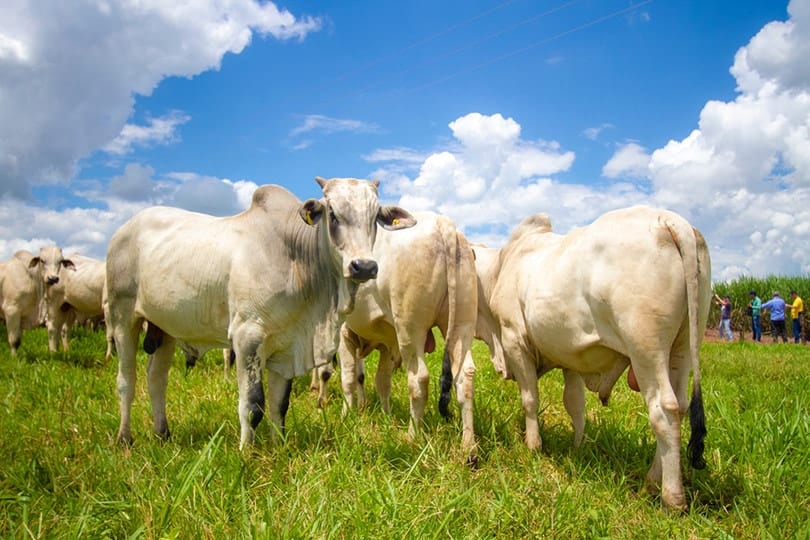The Nelore cattle breed is one of the most distinctive-looking cattle breeds in the world. Their beautiful silver-white coats and camel-like neck humps make them stand out amongst other breeds. And though they originated in Brazil and India, a small number have made it to Western markets, including the United States.
This prized breed is well-known for its easy adaptability and management, flavorful meat, and ability to be crossbred. There are over 75 recognized cattle breeds in the US, and the Nelore breed makes up a very small percentage of its beef production. However, in Brazil, its originating country, they make up for more than 70% of beef production in the entire country. Continue reading to learn more about this unique cattle breed.

Quick Facts About Nelore Cattle Breed
| Breed Name: | Nelore (Bos indicus) |
| Place of Origin: | India/Brazil |
| Uses: | Meat and Breeding |
| Bull (Male) Size: | 1100 lbs. |
| Cow (Female) Size: | 990 lbs. |
| Color: | White |
| Lifespan: | 15-20 years, 4-6 for slaughter |
| Climate Tolerance: | Hot and Cold Regions |
| Care Level: | Average |
| Production: | Over 6o% or the worlds beef bovine production |
Origins
The Nelore cattle breed has origins dating back to a little over 2,000 years ago in India, though they were later bred in large numbers in Brazil. Originally, this breed was referred to as “Ongole” and was later renamed Nelore. Over the centuries, Nelore cattle have stood up well against extreme hot and cold weather conditions and the sweltering conditions common near the Bengal Sea in Brazil. Over time, these conditions allowed the breed to develop genes easily adaptable to extreme temperatures.

Characteristics
The Nelore cattle breed has distinctive physical characteristics, foraging habits, and reproductive abilities that are worth noting. However, their main selling point is their hardiness. This breed withstands cold and hot temperatures very well. Even newborn cattle need little human intervention, as they begin to feed and walk almost immediately and are closely cared for by their mothers.
Nelore are also noted for their incredible physical strength and ability to thrive in conditions that are less than sanitary and lacking in nutrition. This hardiness allows them to surpass many other cattle breeds that live under similarly poor conditions such as drought or unfavorable pastors.
Heat and Pest Resistance
Nelore cattle, similar to other cattle, have loose skin, and wide frames. They also have humongous sweat glands that are about 25-35% larger than most cattle breeds found in Europe and South America–this is about twice the size of many other breeds. Though their topcoat is a grayish-white, their skin is actually black, which helps them easily filter out harmful UV rays.
They have high resistance to heat which causes them to have a low metabolism. As a result, this cattle breed feeds less often than many others, and they also generate less internal body heat. The breed also has a natural resistance to small cattle pests and other insects such as mosquitoes, gnats, horn flies, fleas, and heel flies.
This allows them to be especially impervious to certain diseases that commonly result from blood-sucking parasites. Nelore cattle have also developed a subcutaneous layer of muscle that allows them to quickly shake their coat to remove insects.

Diet and Metabolism
Nelore feed on grass mostly, but also receive a concentrated diet of soy, grain, as well as other daily supplements. They are fairly efficient when it comes to converting low-quality forage material into beef. They can also go long periods, even weeks, without water. This breed feeds lightly but often, which makes them very resistant to cattle bloating–something that can be fatal in the beef industry.
Reproductive Abilities
Nelore cattle have long bodies with short teats and udders (bulls have short heaths). These physical characteristics play a huge role and the cattle’s reproductive qualities. For example, they have a fairly long and active reproductive life, and the female cows have an abundance of milk available for new calves. Female cattle also have a wide pelvic opening and birth canal.
This and their large frame allow them to give birth without much complication, reducing the likelihood of dystocia. Like other breeding cattle, they’ll typically give birth to one calf at a time and between 2 to 4 over their lifetime.
Uses
In Brazil, the main use of Nelore cattle is for meat production and breeding. Their meat is held in high regard for its flavor, leanness, and low calories. The cattle are also fairly easy to manage on a day-to-day basis, and they have just enough fat to keep their meat tender without it becoming tough or stringy.
Meat Quality
The meat of Nelore cattle is very palatable, and though some breeds may contain excessive marbling, overall, it produces fairly lean beef. As low-calorie meat cuts become more popular in Western regions such as the United States and UK, lean cattle such as Nelore are becoming more popular.

Appearance & Varieties
Nelore are large cattle with white topcoats and long bodies. As mentioned previously, they have a significant neck hump that makes them stand out amongst other cattle breeds, and they are especially resistant to parasites and common cattle insects. They also have relatively long legs, which are useful when they are grazing in shallow riverbeds and lakes.
When compared to other cattle, Nelore have short ears, though this doesn’t affect their hearing ability. Their horns are thick, round, and point upward.
Population/Distribution/Habitat
The Nelore cattle has the biggest population in its native Brazil, which is estimated to be a little above 5 million. Though they face certain breeding challenges due to genetic gains, they are still prevalent in the country and have increased in number of exports each year. As of today, Nelore are still gaining popularity in beef markets in Brazil, India, and the United States.
Are Nelore Cattle Good for Small-Scale Farming?
Nelore cattle are typically used for large-scale breeding. However, they may be a good fit for small-scale farming. Their efficient foraging capability allows them to have a high beef conversion in relation to their feeding habits. They can easily convert forages (even unfavorable ones) into quality, nutritious beef.
Another advantage is the ability of calves to thrive without much human intervention, which helps to reduce small farmer labor. However, a major consideration will be the size of the land and the availability of feeding equipment, care facilities, and day-to-day labor. All of these things are crucial for productive beef cattle operations regardless of the cattle breed. Though Nelore cattle are fairly easy to maintain, they still require typical cattle resources, including daily feeders (or pasture grass), healthcare, waterers, trailers, transportation, and fencing.
Conclusion
Nelore cattle are one of the most popular cattle used for beef and breeding in their native Brazil. They’re highly noted for their ability to adapt to extreme weather conditions, impressive heat resistance, and ability to thrive on lower-quality forage. Overall, Nelore cattle are fairly easy cattle to breed, and their delicious, high-quality beef makes them one of the staple breeds used for beef.
Featured Image Credit: Leonidas Santana, Shutterstock
